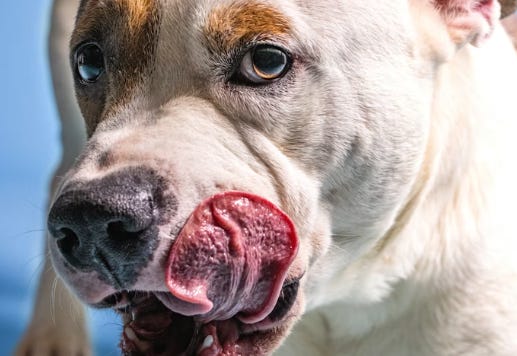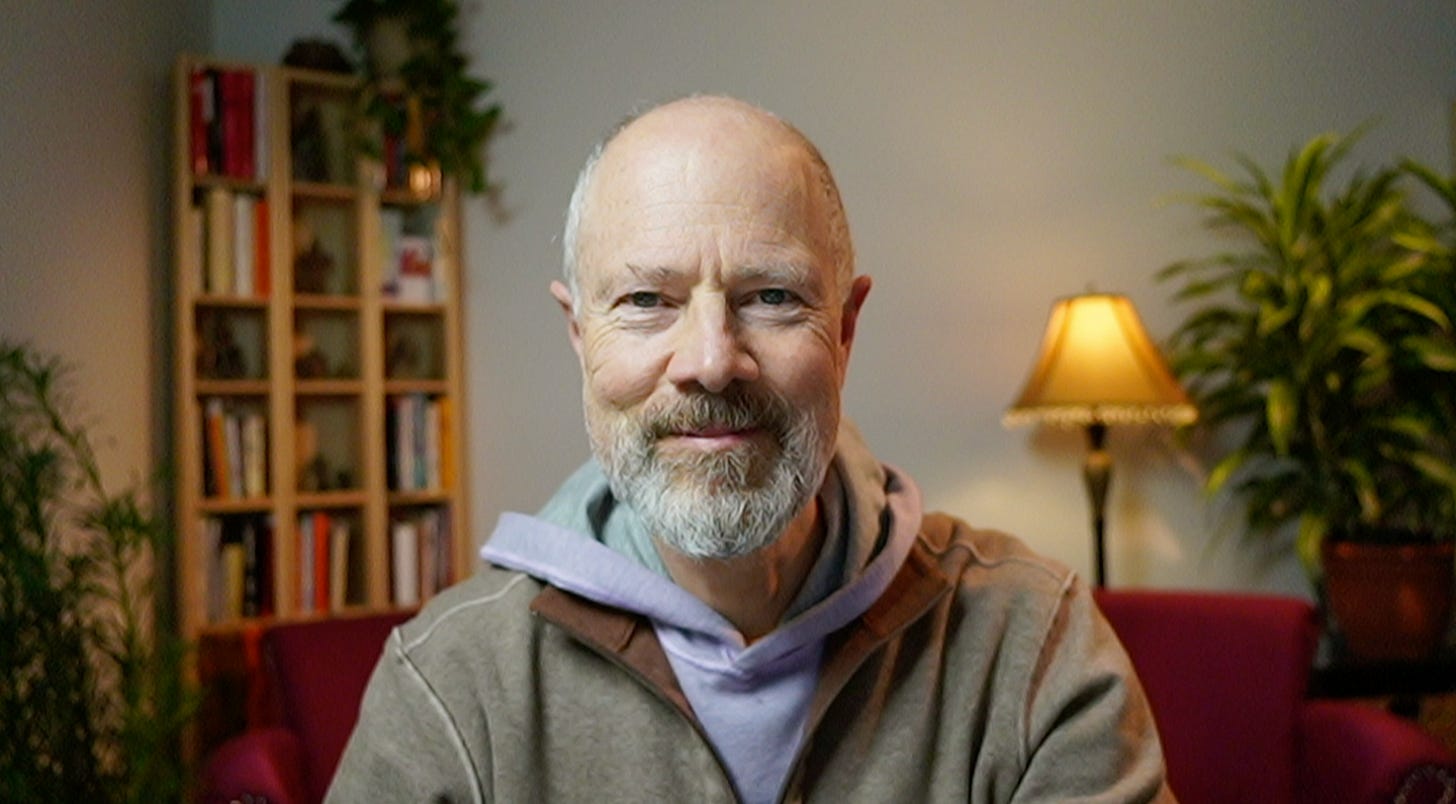When Challenges Come Out to Play
What a pit bull taught me about facing my problems
My plan was to go for a relaxing run.
A powdered-sugar snow had fallen on the Douglas-fir and quaking aspen during the night where I was staying with friends in Boulder, Colorado. The combined lower than usual temperature and higher than usual altitude left me laboring to extract oxygen from the thin, crystalline air as I jogged down the driveway.
I was scheduled to depart that morning, continuing a cross-country driving trip from the west coast to my parents home in Arkansas and wanted to get some exercise before the day’s journey. Each of the surrounding rural homes sat on five to twenty acres of land, so rather than sticking to the long private drive to reach the main road I decided to cut across one corner of the neighboring property—which as it turns out, was a rookie, city boy move.
Almost immediately, I heard fierce barking coming from the direction of the adjacent house in the distance, and turning toward the territorial bellow I saw a dog racing toward me through plumes of flying snow.
This brought immediate alarm, but I calmed myself with the expectation that, of course, there’d be a fence, a chain, or perhaps even an owner to intervene before a reactive dog like this would be permitted to approach a neighboring human.
And yet I watched as this guard dog bounded toward me, more aerial than terrestrial, rapidly shrinking the distance between my stranded location and its salivating jowls. There was nowhere to go, nothing to hide behind, and I knew that running would have resulted in a trip to the emergency room and a long row of stitches. And yet staying put didn’t look like a good option either. My brain provided a clear and succinct analysis of the situation.
“You’re dead.”
But since I wasn’t dead yet, I had no choice but to square off with the incoming enemy.
I marveled at the physiological efficiency of my system as several gallons of adrenaline were suddenly injected into my bloodstream and I became battle-ready in a matter of seconds. Moments before the imminent attack, I did what they taught me in Boy Scouts: made myself look as large and imposing as possible. I rose up to full height, raised my hands in the shape of menacing claws and started growling and roaring like a feral, wounded beast.
I wasn’t the only one who was surprised by this; the pit bull screeched to a halt about eight feet away, skidding up short in a pile of snow and a sudden breach of confidence.
We squared off facing each other, each producing a riot of sounds, twisted grimaces, and a display of teeth that would hopefully convince the other we weren’t to be messed with. I noticed how good my opponent was at this. Ferocity came naturally to him, just doing his job well on this crisp, sunny day. I was less used to expending a month’s worth of calories in exchange for a few extra minutes of existence on planet earth.
I imagined the sun making a full trip across the sky during the eternity of our stand-off. In reality, probably three minutes had elapsed when I saw an American pit bull do something I never would have imagined in the midst of a mounted assault.
Daydream.
I personally knew that allowing my attention to lapse for even a moment would be disastrous, but to my utter surprise, the pit bull’s focus began to drift.
It was almost imperceptible at first—its gaze momentarily following a speck of falling snow in the sunlight, then snapping back to glower at me. A minute later, a rising scent on the wind invited the investigation of a distant odor; it lifted its nose to explore the aroma, and then again returned to the task of posturing as a baleful threat. Scampering squirrels, the call of a warbler or mockingbird, the far-off hum of a snowmobile, one-by-one, the particulars of our surroundings created sensory diversions that it briefly entertained, providing me with fleeting windows of freedom.
Each time the dog would drift, I took one small step backward. Like a reverse game of red-light, green-light; where the objective was to get farther away from the caller rather than closer while avoiding detection. As the durations of attention drift grew longer, I was able to put two steps, then three steps between us during each lapse of focus without the hound registering that I was escaping in slow motion.
Eventually I had backed up all the way to the road, and when I started to jog slowly away down the snow-packed country trail, the dog turned around and wandered home.
This was a startling revelation for me that I’ve been able to make use of throughout my life.
When faced with a bank account that was running on fumes as an entrepreneur, staying alert revealed skills, opportunities and income sources that were right under my nose. When my partner has looked to me like the enemy, but I manage a small word of kindness after pausing to remember my vows, the stand-off has given way to reconnection. When a recent injury seemed to make movement impossible, curiosity helped me discover a remaining range of motion that allowed me to function.
Our challenges often seem to be relentless and intractable, appearing as continuous, inescapable assaults—but when you actually get completely present with the problem, what you notice is that the problem itself is not fully fixated on you. Most challenges are a sort of natural phenomenon, an act of nature, rather than targeted personal adversaries. They are whimsical even—filled with gaps, idiosyncrasies, and potential.
My father took me into a fun-house maze at a traveling amusement park when I was kid. The labyrinth of mirrors and glass was overwhelming, and I found myself frightened by his suggestion that I could find my own way through.
Until he gave me a hint.
“If you put your hand out on one wall and then walk forward while maintaining contact with the maze, you’re guaranteed to reach the end.”
Miraculously, he was right.
The solution to a problem is contained in the problem itself, as the philosophical truism goes.
Even the most intimidating problems are more mischievous than menacing at heart. They don’t adhere to the ordered narrative we make up about how personal or permanent they are as an obstacle. Big problems change their mind, lose interest in thwarting us, or happily show us a secret passage through the middle of them when we get curious and poke around.
It seems like a good time to consider that our biggest challenges are not trying to devour us. They’re trying to get us to pay closer attention because the way out or through is right in front of us if we stand up tall and stay in the game when a problem comes running across the yard to play.
Big thanks to and for editing suggestions and conversation with me about the development of this story.
➡️ Backstage Pass
I’ve published a story about a personal experience every week for the last 143 weeks in a row, and not because it’s going to make me a million dollars, but because every time I review a notable life experience I learn more about myself and provide more human surface area for authentic connection with others.
I keep a list of notable life stories that I might want to share one day and I review the list frequently. At some point during the week one of these life events will usually appear in my memory and I’ll follow that spontaneous arising to explore it in writing.
This pit bull story that happened decades ago in my early twenties has been an unresolved trauma that has impacted my relationship to dogs ever since. My own family brought a dog into the house several years ago and there’s been a persistent tension around our adoption of it, due in good part to this past experience and other negative interactions I had with dogs as a kid.
I think this memory popped into my mind because a part of me is ready to build a new relationship to dogs in general, to turn my fear of attack into enthusiasm to connect. Interestingly, I had another notable dog encounter with my son just recently that I also wrote about.
Life happens so fast that our life experiences often get quickly saddled with old meanings that don’t serve us, and can even block our present day aims and goals. Going back, reviewing them, and building more empowering narratives around them can be very useful.
💬 Featured Comment
My story from last week was called Painful Corrections
My favorite comment on this post came from
who wrote:“Interesting how the perspective can change in an instant, Rick – the lady you followed is such a good example. You had good intentions, but I can well imagine why she was terrified!
I’m thinking of times when I’ve spoken up. Years ago, I was staying in a bed & breakfast with my three-year old son. I’d just put him to bed, when a massive argument kicked off between the female proprietor, who lived in the basement, and her boyfriend. It sounded verbal, not physical, but he was really berating her. I was unsure whether to go down and knock at the door, or call the police, or do nothing. It eventually simmered down, so I didn’t act.
Next morning, serving breakfast, she acted completely normally, but I told her afterwards (in private) that we wouldn’t stay the second night we’d booked. She was astonished when I told her that we’d overheard the argument and that was the reason we were leaving. (And no, I wouldn’t pay for the second night.)
I hope my mentioning it jolted her into realising she was in a destructive relationship – and one that was bad for her business.”
Wendy’s comment sparked a bit of discussion between she and I and a few other readers.
You can see the full thread here.
📘 Story of the Week
My favorite story this week comes from
who published an account of being with his dad shortly before his passing. It’s a deeply moving celebration of his father.💭 Favorite Conversation
I love to engage with the work of other authors and this was one my favorite exchanges this week with
on his wonderful piece titled, The Mantra That Kills Conflict at the Root.🤝 Get Help With Storytelling
I love to talk about the art of storytelling and its many benefits.
Book a time with me to chat about your own life stories and how you can strengthen your connection with them for personal growth, professional development, brand building, public speaking, or your published writing.





